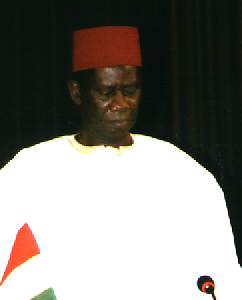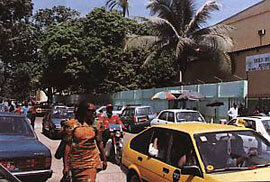 INTRODUCTION INTRODUCTION

Everyone has heard about Guinea pigs or Guinea fowl, but few people have heard of Guinea. In fact the Republic of Guinea is often confused with Guinea Bissau - its neighbor -, Equatorial Guinea or even Papua-New Guinea. This lack of identity is due to the country’s past policy of closed doors. Lately something stirs in Guinea, and it was about time. The Republic of Guinea suffered for too long under one of the most oppressive regimes in the world. Sekou Touré, the despotic dictator who ruled the country for 26 years (1958-1984), left deep scars in one of the richest countries in Africa. It is only recently that Guinea has started healing its wounds and has opened up to the world.
 OF EMPIRES AND SLAVES OF EMPIRES AND SLAVES
Guinea is already mentioned in VIII century Berber records, and the history of this little known country is linked to that of the vast Empires of Western Africa, most notably that of Mali, which flourished between the XIII and XV centuries. The first time Guinea appeared in world charts was in the XIV century encompassing the coastal area from Senegal to Gabon.
Around the XVIII century the hegemony of the Malian rulers (the Malenke‚ ethnic group) was challenged by a new ethnic group migrating into their territory: the Peul, an ethnic group of nomadic herders and descendants of the Sudanese. The Peul took over the central plateau of the Fouta Djalon during the jihad (holy Islamic war) of 1725.
Trade with Europe started in the XV century, but western settlements only started in the XVII century. Due to the proximity with Europe and the Americas, Guinea and the neighboring countries were an excellent platform for the lucrative slave trade. Colonial powers - Portugal, England and France - traded with local chiefs, obtaining cheap hard labor workers. Borders started to get more clearly defined as the European empires increased their presence in the area. France got hold of the territory of Guinea creating French Guinea in 1891.
|

 INDEPENDENCE AND COMMUNISM INDEPENDENCE AND COMMUNISM
Guinea was ruled by a Vice-governor who depended on the authority of the Governor of Senegal, making Guinea a second rate colony despite its rich resources. The situation was quite stable until the end of WW II, when all colonial empires started disintegrating. France was no exception. When the independence movement challenged the metropolis, general De Gaulle presented Guinea two choices: autonomy - becoming part of the French commonwealth - or independence.
The leader of the strongest trade union in the French West African Colonies, Sekou Touré, was the leader of the independence movement. When confronted by the choice of autonomy or independence, he proudly refused being part of the French commonwealth, preferring the second path. He thought he would be backed by his colleagues from Ivory Coast and Senegal, who in the end left him alone. Guinea thus gained its independence October 2nd 1958, but together with its independence, started its decline.
General De Gaulle turned his back to the ex-colony leaving it without any political or financial support. France’s allies declined to help the newly independent country knowing the negative consequences this would carry for them. Hence Guinea - one of the most flourishing colonies of the French Empire - was left on its own.
Sekou Touré, desperately needy of foreign help, turned to the USSR who promptly offered its aid. So started a communist regime which in the long run meant the fall of the country and caused its ruin. Relations with the Soviets were not that hot either. In 1961 the Soviet Ambassador was kicked out of the country, alleging interference in Guinea’s internal affairs. Nevertheless, the socialist path continued, and in 1967 a Chinese style cultural revolution started.
This revolution produced an exodus of around 2 million Guineans abroad, especially the intelligentsia, impoverishing the country even further. Communist countries such as the USSR, China, Rumania, Cuba or North Korea continued economical relations with Guinea, but the USA had to provide food aid to prevent the population from starving. Due to its erratic and capricious economic policy, Guinea was pushed down to the bottom of the list of the poorest countries on the planet, occupying that ominous position in 1992, 1993 and 1994. What few know is that despite all that Guinea is sitting on a fortune of gold, diamonds, iron... and all kinds of natural resources. |

